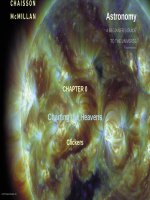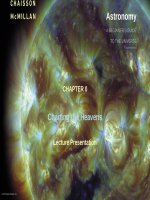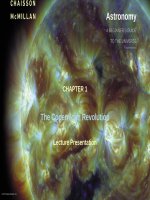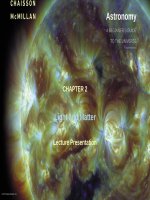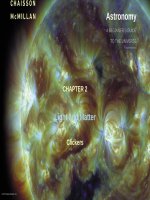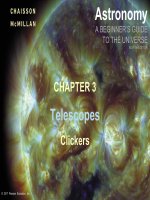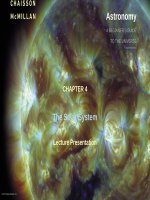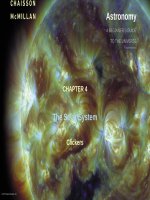Astronomy a beginners guide to the universe 8th CHaisson mcmillan chapter 00 clicker questions
Bạn đang xem bản rút gọn của tài liệu. Xem và tải ngay bản đầy đủ của tài liệu tại đây (1.35 MB, 25 trang )
Astronomy
A BEGINNER’S GUIDE
TO THE UNIVERSE
EIGHTH EDITION
CHAPTER 0
Charting the Heavens
Clickers
© 2017 Pearson Education, Inc.
Question 1
Constellations appear to move across the sky at night because the
a)
b)
c)
d)
e)
© 2017 Pearson Education, Inc.
Earth orbits the Sun.
Moon orbits the Earth.
stars are in constant motion.
Sun orbits the Earth.
Earth spins on its axis.
Question 1
Constellations appear to move across the sky at night because the
a)
b)
c)
d)
e)
Earth orbits the Sun.
Moon orbits the Earth.
stars are in constant motion.
Sun orbits the Earth.
Earth spins on its axis.
Explanation: The Sun, Moon,
planets, and stars all rise and set
because our planet rotates once
each day.
© 2017 Pearson Education, Inc.
Question 2
What causes Earth’s seasons?
a)
b)
c)
d)
e)
© 2017 Pearson Education, Inc.
Wobble of Earth’s rotation axis
The greenhouse effect
23.5º tilt of Earth’s rotational axis
Movement of Earth closer to or farther from the Sun
Global warming and cooling
Question 2
What causes Earth’s seasons?
a)
b)
c)
d)
e)
Wobble of Earth’s rotation axis
The greenhouse effect
23.5º tilt of Earth’s rotational axis
Movement of Earth closer to or farther from the Sun
Global warming and cooling
Explanation: Our planet’s tilt,
and not its changing distance
from the Sun, creates seasons.
© 2017 Pearson Education, Inc.
Question 3
What is the path that the Sun, Moon, and planets follow through the constellations?
a)
b)
c)
d)
e)
© 2017 Pearson Education, Inc.
The celestial equator
The north celestial pole
The Milky Way
The zodiac
The ecliptic
Question 3
What is the path that the Sun, Moon, and planets follow through the constellations?
a)
b)
c)
d)
e)
The celestial equator
The north celestial pole
The Milky Way
The zodiac
The ecliptic
Explanation: The ecliptic
also marks the plane of
Earth’s orbit around
the Sun.
© 2017 Pearson Education, Inc.
Question 4
How long does it take the Sun to complete one circuit of the ecliptic?
a)
b)
c)
d)
e)
© 2017 Pearson Education, Inc.
1 hour
1 day
1 month
1 year
1 decade
Question 4
How long does it take the Sun to complete one circuit of the ecliptic?
a)
b)
c)
d)
e)
1 hour
1 day
1 month
1 year
1 decade
Explanation: The Sun
moves around the
ecliptic once as the Earth
orbits in 1 year.
© 2017 Pearson Education, Inc.
Question 5
How long does it take the Moon to go around the ecliptic?
a)
b)
c)
d)
e)
© 2017 Pearson Education, Inc.
1 day
1 hour
1 week
1 month
1 year
Question 5
How long does it take the Moon to go around the ecliptic?
a)
b)
c)
d)
e)
1 day
1 hour
1 week
1 month
1 year
Explanation: The Moon orbits Earth in 1 month, and passes in front of the constellations of the zodiac, which are
arranged around the ecliptic.
© 2017 Pearson Education, Inc.
Question 6
Stars in a constellation are
a)
b)
c)
d)
e)
© 2017 Pearson Education, Inc.
physically close to each other.
usually equal in brightness.
about the same age.
about the same distance away.
in the same part of the sky.
Question 6
Stars in a constellation are
a)
b)
c)
d)
e)
physically close to each other.
usually equal in brightness.
about the same age.
about the same distance away.
in the same part of the sky.
Explanation: Stars within a
constellation might be very
different distances, ages, types,
and brightnesses.
© 2017 Pearson Education, Inc.
Question 7
A total lunar eclipse occurs
a)
b)
c)
d)
© 2017 Pearson Education, Inc.
during the new Moon phase.
when the Sun blocks the Moon.
during the full Moon phase.
always around the summer solstice.
Question 7
A total lunar eclipse occurs
a)
b)
c)
d)
© 2017 Pearson Education, Inc.
during the new Moon phase.
when the Sun blocks the Moon.
during the full Moon phase.
always around the summer solstice.
Question 8
The vernal equinox marks the beginning of
a)
b)
c)
d)
© 2017 Pearson Education, Inc.
summer.
fall.
winter.
spring.
Question 8
The vernal equinox marks the beginning of
a)
b)
c)
d)
summer.
fall.
winter.
spring.
Explanation: The vernal
equinox occurs
around March 21–22.
© 2017 Pearson Education, Inc.
Question 9
Conditions are favorable for a solar eclipse
a)
b)
c)
d)
e)
© 2017 Pearson Education, Inc.
every month at new Moon.
every week at the quarter phases.
every month at full Moon.
about every 6 months at new Moon.
every year at new Moon.
Question 9
Conditions are favorable for a solar eclipse
a)
b)
c)
d)
e)
© 2017 Pearson Education, Inc.
every month at new Moon.
every week at the quarter phases.
every month at full Moon.
about every 6 months at new Moon.
every year at new Moon.
Question 10
The angle of parallax increases as
a)
b)
c)
d)
© 2017 Pearson Education, Inc.
distances to stars increase.
the baseline gets larger.
the baseline gets smaller.
Earth moves faster in its orbit.
Question 10
The angle of parallax increases as
a)
b)
c)
d)
distances to stars increase.
the baseline gets larger.
the baseline gets smaller.
Earth moves faster in its orbit.
Explanation: The greater the distance
between two observation points (the
baseline), the larger the angle of
parallax.
© 2017 Pearson Education, Inc.
Question 11
Precession is caused by the
a)
b)
c)
d)
e)
rotation of Earth’s molten core.
gravitational pull of the Sun.
gravitational pull of the Moon.
weight of the ice at the poles.
gravitational attractions
from comets.
© 2017 Pearson Education, Inc.
Question 11
Precession is caused by the
a)
b)
c)
d)
e)
rotation of Earth’s molten core.
gravitational pull of the Sun.
gravitational pull of the Moon.
weight of the ice at the poles.
gravitational attractions
from comets.
Explanation: The Moon’s tug
creates a slow “wobble” that
takes 26,000 years for one
rotation.
© 2017 Pearson Education, Inc.
Question 12
Considering the Moon’s phases, everyone on Earth sees
a)
b)
c)
d)
© 2017 Pearson Education, Inc.
the same phase in 24 hours.
different phases in 24 hours.
a lunar eclipse once a month.
different sides of the Moon.
Question 12
Considering the Moon’s phases, everyone on Earth sees
a)
b)
c)
d)
the same phase in 24 hours.
different phases in 24 hours.
a lunar eclipse once a month.
different sides of the Moon.
Explanation: The Moon goes
through its cycle of phases in
about 30 days; Earth rotates
once in only 24 hours.
Thus, everyone has a chance to
see the same phase!
© 2017 Pearson Education, Inc.
